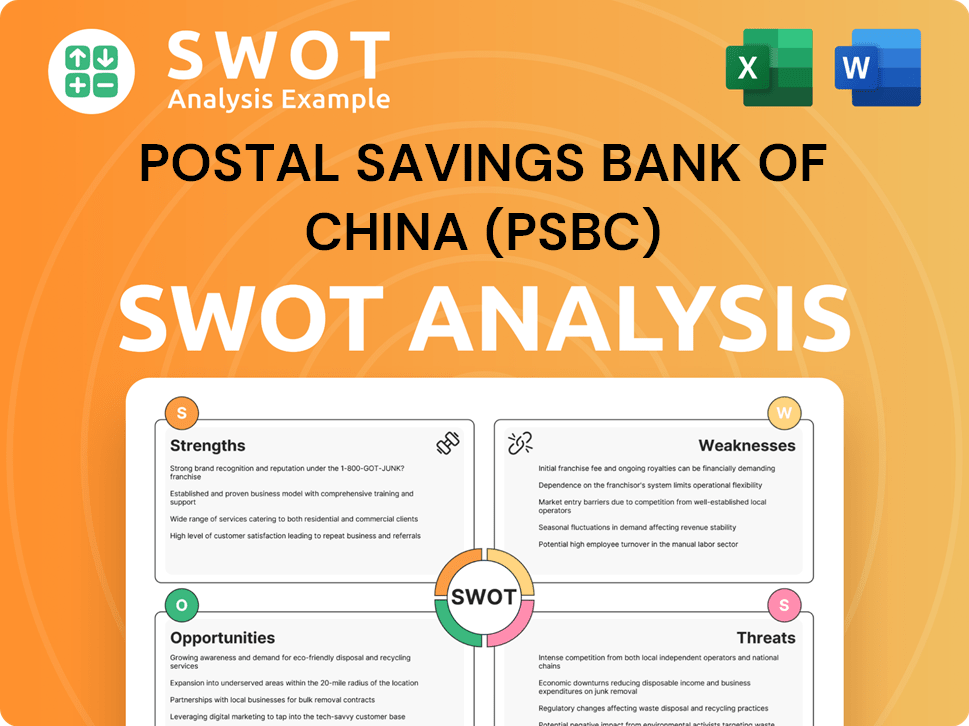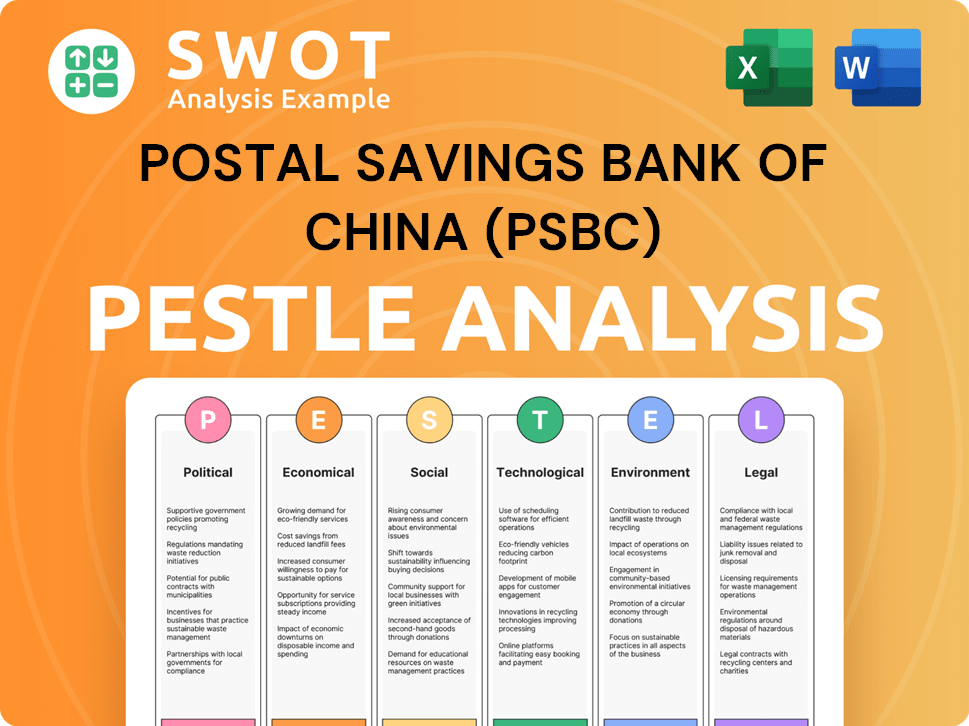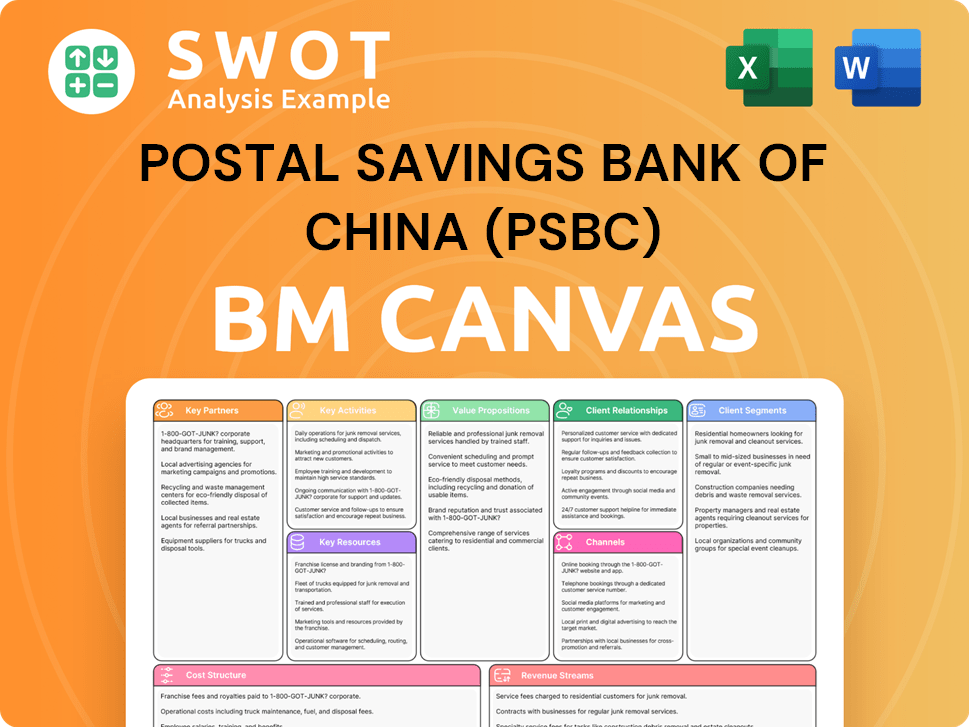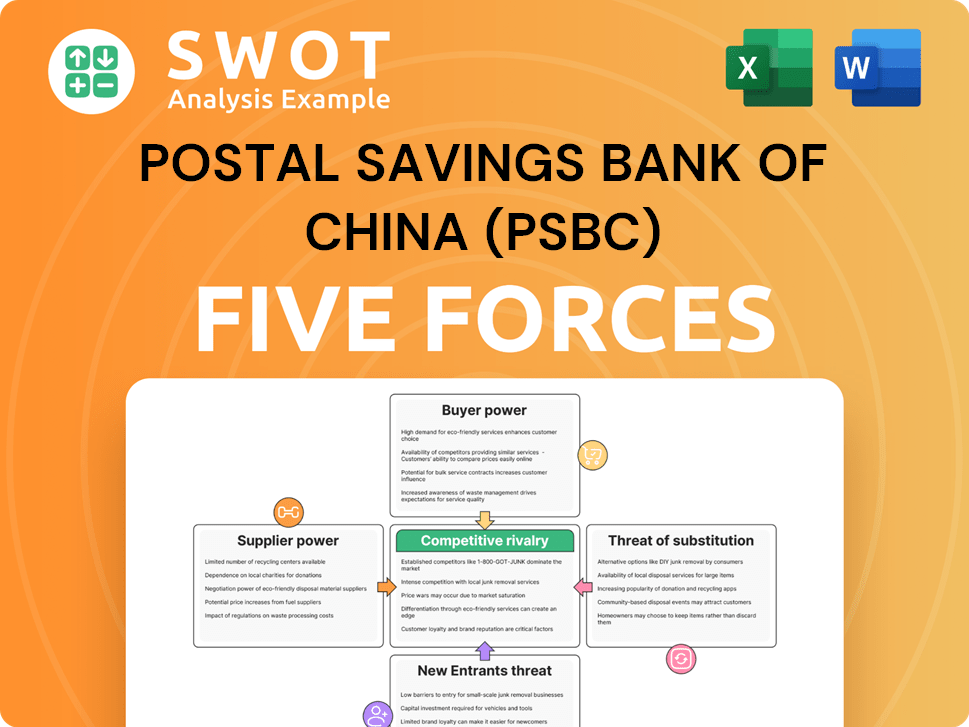Postal Savings Bank Of China (PSBC) Bundle
How has Postal Savings Bank of China (PSBC) transformed its sales and marketing?
Founded in 2007, Postal Savings Bank of China (PSBC) has evolved from a savings and remittance provider to a comprehensive commercial retail bank. Initially leveraging the extensive China Post network, PSBC built a massive customer base, particularly in rural areas. This strategic shift, coupled with a commitment to "Sannong business," has shaped its trajectory.

This exploration dives deep into PSBC's Postal Savings Bank Of China (PSBC) SWOT Analysis, examining how it effectively reaches customers through various sales channels, and the marketing tactics used to build awareness and drive sales. We'll analyze its brand positioning within a competitive landscape, highlighting key campaigns and digital marketing initiatives that have fueled recent growth. Understanding PSBC's banking strategy provides valuable insights for financial services marketing professionals and those interested in PSBC marketing plan.
How Does Postal Savings Bank Of China (PSBC) Reach Its Customers?
The Postal Savings Bank of China (PSBC) employs a multifaceted sales and marketing strategy, leveraging a comprehensive mix of online and offline sales channels to reach its diverse customer base. A significant strength of PSBC lies in its extensive physical network, which is a cornerstone of its banking strategy.
As of the end of 2024, PSBC operated nearly 40,000 outlets across China, covering all urban cities and 99% of counties. This expansive reach makes it the bank with the largest distribution network in the country. This vast network includes both directly operated outlets and a significant number of agency outlets managed by its parent, China Post Group.
The agency model, where China Post Group manages outlets, is crucial for securing a strong deposit franchise, especially in rural and less-developed areas where PSBC holds a dominant market share. This extensive physical presence is a key element in PSBC's sales performance analysis, allowing it to serve a broad spectrum of customers effectively.
PSBC's primary offline sales channel is its extensive network of branches and agency outlets. These outlets are strategically located to maximize accessibility for customers across both urban and rural areas. The physical presence allows for direct customer interaction, providing a personal touch in financial services marketing.
Agency outlets, managed by China Post Group, contribute significantly to PSBC's deposit base. These agencies are particularly important in rural areas, where they offer essential banking services. This model supports PSBC's customer acquisition strategies by extending its reach into underserved markets.
PSBC has been actively promoting digital transformation, with technology investments reaching CNY 12.3 billion or 3.5% of total revenue in 2024. This includes the development of online cloud service platforms and mobile banking services. These initiatives are integral to PSBC's digital marketing initiatives.
The bank has introduced digital platforms like 'PSBC Facilitates Corporate Operation,' a one-stop digital management platform for enterprises. By the end of March 2024, this platform had served 14.0 thousand clients cumulatively. This blend of traditional and digital channels allows PSBC to maintain its deep penetration in rural areas while expanding its reach.
PSBC's strategy involves the integration of traditional and digital channels to optimize customer experience and operational efficiency. This approach ensures that customers can access services through their preferred channels. This omnichannel strategy is key to PSBC's brand building strategies.
- Mobile Banking: PSBC's mobile banking services provide convenient access to financial services.
- Online Platforms: Online platforms support queries, business handling, and financial transactions.
- Branch Network: The extensive branch network provides in-person support and services.
- Digital Transformation: Continuous investment in technology enhances service capabilities.
Postal Savings Bank Of China (PSBC) SWOT Analysis
- Complete SWOT Breakdown
- Fully Customizable
- Editable in Excel & Word
- Professional Formatting
- Investor-Ready Format

What Marketing Tactics Does Postal Savings Bank Of China (PSBC) Use?
The Sales and Marketing Strategy of Postal Savings Bank of China (PSBC) involves a blend of digital and traditional marketing tactics. This approach aims to enhance brand awareness, generate leads, and boost sales across diverse customer segments. The bank leverages data-driven marketing extensively, utilizing technology to create detailed customer profiles and personalize financial solutions.
PSBC's marketing strategy includes a strong emphasis on digital initiatives and traditional media, such as TV, radio, and print, to reach a broad audience. Furthermore, the bank actively engages in community outreach and partnerships to support its inclusive finance goals. This comprehensive strategy underscores PSBC's commitment to sustainable growth and customer-centric services.
By the end of 2024, PSBC had deployed over 8,000 analytical models and strategic plans, which significantly improved customer identification and lead generation. This data-driven approach allowed for a 50% reduction in manual marketing costs and an AI-powered customer service replacement rate exceeding 85%. This digital transformation is a key component of the bank's marketing efforts.
PSBC utilizes data-driven marketing to create accurate customer profiles, enabling personalized financial solutions. This approach supports customer segmentation, allowing for targeted outreach and improved efficiency in lead generation.
PSBC continues to leverage traditional media such as TV, radio, and print, as well as local outreach and community events. The bank's presence in rural areas suggests an ongoing reliance on these traditional methods to build brand awareness.
PSBC launched the 'Inclusive Finance Promotion Month' campaign in August 2024 to fulfill financial responsibilities and optimize financial products. The bank also conducts in-depth research on enterprise needs to improve its service models.
PSBC engages in collaborations, such as working with the Shenzhen Stock Exchange to organize equity financing roadshows. It also explores 'loan + external direct investment' models for technology enterprises.
PSBC utilizes data to segment its customer base, enabling the bank to offer personalized financial solutions. This targeted approach enhances customer satisfaction and improves marketing effectiveness.
PSBC has implemented AI-powered customer service, which has achieved a replacement rate exceeding 85%. This technological advancement improves customer service efficiency and reduces operational costs.
PSBC's marketing strategy is designed to reach a broad audience through a combination of digital and traditional methods. The bank focuses on data-driven insights to personalize customer experiences and improve marketing effectiveness. The bank's approach to Revenue Streams & Business Model of Postal Savings Bank Of China (PSBC) is heavily influenced by its marketing strategies.
- Data-driven marketing for customer profiling and segmentation.
- Use of traditional media and community engagement for broader reach.
- Inclusive finance campaigns and partnerships to support financial inclusion.
- Focus on AI-powered customer service to enhance efficiency.
- Continuous optimization of financial products and service models.
Postal Savings Bank Of China (PSBC) PESTLE Analysis
- Covers All 6 PESTLE Categories
- No Research Needed – Save Hours of Work
- Built by Experts, Trusted by Consultants
- Instant Download, Ready to Use
- 100% Editable, Fully Customizable

How Is Postal Savings Bank Of China (PSBC) Positioned in the Market?
The Postal Savings Bank of China (PSBC) strategically positions itself as a major state-owned commercial retail bank. This positioning is unique due to its dual focus on serving 'Sannong' (agriculture, countryside, and farmers), urban and rural residents, and small and medium-sized enterprises (SMEs). This approach allows PSBC to differentiate itself from competitors, especially through its deep penetration and long-standing presence in rural areas, where it holds a dominant market position.
PSBC's core message emphasizes fulfilling its political, economic, and social responsibilities. This alignment with national strategies, such as rural revitalization and inclusive finance, strengthens its brand image. The bank aims to be accessible and reliable, committed to serving underserved populations, and integrating consumer protection into its business development strategies. This approach is crucial for its Sales and Marketing Strategy.
The bank highlights its role in technology finance, green finance, pension finance, and digital finance. This indicates a forward-looking and innovative aspect of its brand. PSBC's digital intelligence transformation aims to offer an interconnected online and offline service system. In 2024, PSBC ranked 12th in The Banker's 'Top 1000 World Banks', demonstrating its strong market influence and stability.
PSBC's Banking strategy focuses on 'Sannong', urban and rural residents, and SMEs. This broadens its customer base and supports inclusive finance. This focus is a key component of its PSBC marketing plan.
The brand emphasizes accessibility, reliability, and commitment to underserved populations. It provides comprehensive Financial services marketing that improves people's well-being. This is crucial for PSBC customer acquisition strategies.
PSBC is undergoing a digital intelligence transformation. This includes offering an interconnected online and offline service system. This enhances its PSBC digital marketing initiatives.
PSBC's strong market influence and stability are recognized by its high ratings from international agencies. In 2024, PSBC ranked 12th in The Banker's 'Top 1000 World Banks'.
PSBC distinguishes itself through several key factors, including its focus on underserved populations and its strong presence in rural areas. These elements are critical to its PSBC sales performance analysis.
- Deep penetration in rural areas.
- Commitment to inclusive finance.
- Integration of consumer protection.
- Emphasis on technology and digital finance.
Postal Savings Bank Of China (PSBC) Business Model Canvas
- Complete 9-Block Business Model Canvas
- Effortlessly Communicate Your Business Strategy
- Investor-Ready BMC Format
- 100% Editable and Customizable
- Clear and Structured Layout

What Are Postal Savings Bank Of China (PSBC)’s Most Notable Campaigns?
The Postal Savings Bank of China (PSBC) has launched several key campaigns to bolster its sales and marketing strategy. These initiatives reflect PSBC's commitment to inclusive finance, digital transformation, and specialized financial services. The bank actively targets various customer segments, leveraging both traditional and innovative approaches to enhance its market presence and customer engagement.
One of the most significant campaigns is the 'Inclusive Finance Promotion Month,' which began in August 2024. This campaign underscores PSBC's dedication to providing financial services to a broad range of customers. Simultaneously, PSBC is pushing for digital transformation and specialized financial services. These efforts are designed to improve service delivery and meet the evolving needs of its diverse clientele.
Another key initiative is the promotion of 'PSBC Facilitates Corporate Operation,' a digital management platform for enterprises. This platform has served 14.0 thousand clients by the end of March 2024. In April 2024, PSBC launched 'Sci-Tech Discounting,' a product tailored for technology enterprises.
Launched in August 2024, this campaign focused on understanding the needs of enterprises and optimizing financial products. The goal was to improve the accessibility and satisfaction of inclusive financial services.
A one-stop digital management platform for enterprises. By the end of March 2024, it had served 14.0 thousand clients. This initiative supports the digital transformation of enterprises by providing various core functions.
Launched in April 2024, this innovative product is tailored for 15 types of technology enterprises in Shanghai. It offers preferential pricing and self-service options to support the growth of the tech sector.
PSBC is actively digitalizing its services to enhance efficiency and customer experience. This includes the development and promotion of digital platforms to meet the evolving needs of its customers. These initiatives align with the bank's focus on digital innovation.
Postal Savings Bank Of China (PSBC) Porter's Five Forces Analysis
- Covers All 5 Competitive Forces in Detail
- Structured for Consultants, Students, and Founders
- 100% Editable in Microsoft Word & Excel
- Instant Digital Download – Use Immediately
- Compatible with Mac & PC – Fully Unlocked

Related Blogs
- What are Mission Vision & Core Values of Postal Savings Bank Of China (PSBC) Company?
- What is Competitive Landscape of Postal Savings Bank Of China (PSBC) Company?
- What is Growth Strategy and Future Prospects of Postal Savings Bank Of China (PSBC) Company?
- How Does Postal Savings Bank Of China (PSBC) Company Work?
- What is Brief History of Postal Savings Bank Of China (PSBC) Company?
- Who Owns Postal Savings Bank Of China (PSBC) Company?
- What is Customer Demographics and Target Market of Postal Savings Bank Of China (PSBC) Company?
Disclaimer
All information, articles, and product details provided on this website are for general informational and educational purposes only. We do not claim any ownership over, nor do we intend to infringe upon, any trademarks, copyrights, logos, brand names, or other intellectual property mentioned or depicted on this site. Such intellectual property remains the property of its respective owners, and any references here are made solely for identification or informational purposes, without implying any affiliation, endorsement, or partnership.
We make no representations or warranties, express or implied, regarding the accuracy, completeness, or suitability of any content or products presented. Nothing on this website should be construed as legal, tax, investment, financial, medical, or other professional advice. In addition, no part of this site—including articles or product references—constitutes a solicitation, recommendation, endorsement, advertisement, or offer to buy or sell any securities, franchises, or other financial instruments, particularly in jurisdictions where such activity would be unlawful.
All content is of a general nature and may not address the specific circumstances of any individual or entity. It is not a substitute for professional advice or services. Any actions you take based on the information provided here are strictly at your own risk. You accept full responsibility for any decisions or outcomes arising from your use of this website and agree to release us from any liability in connection with your use of, or reliance upon, the content or products found herein.